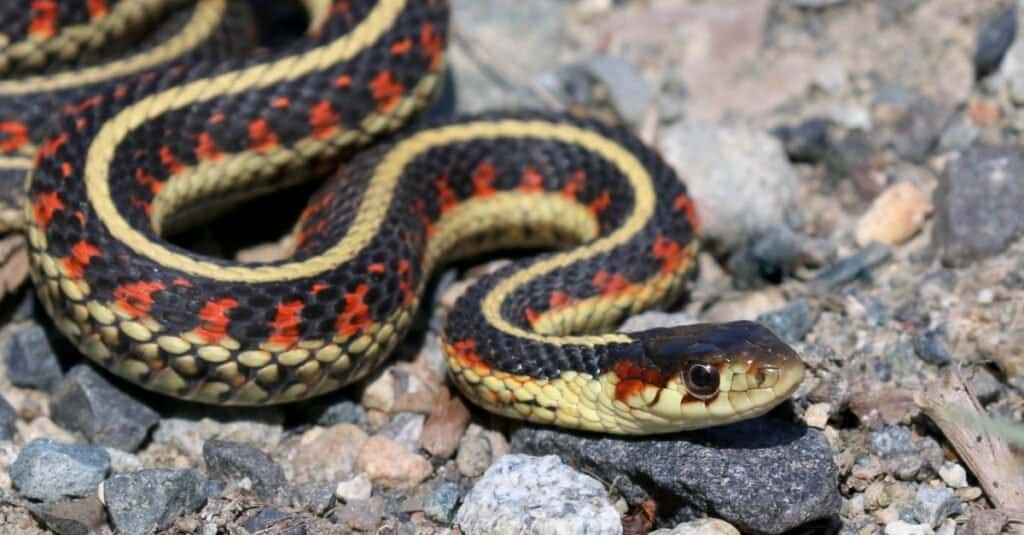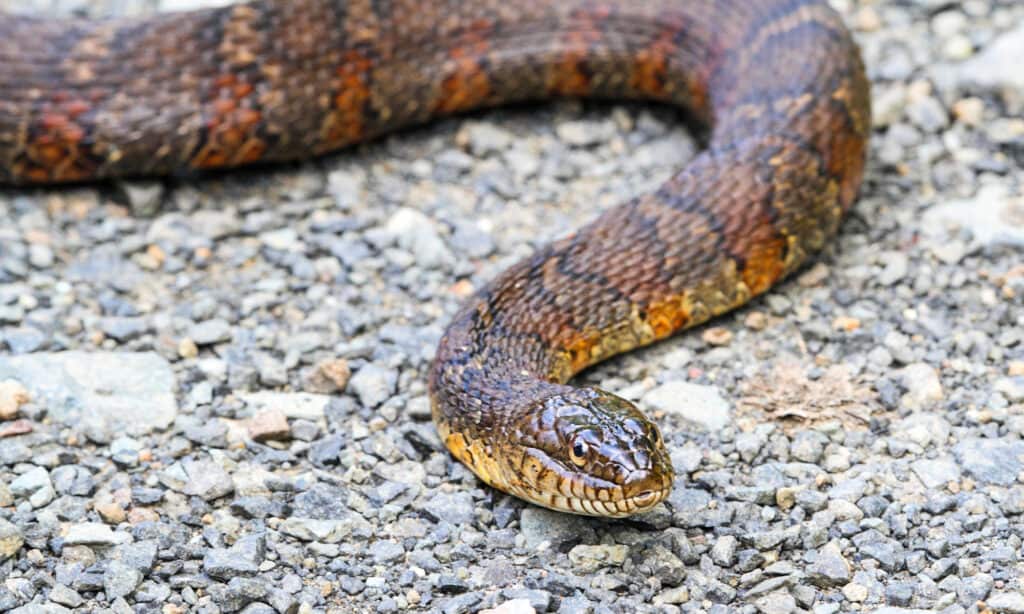In the state known for the Kentucky Derby, Mammoth Cave National Park, and bluegrass music, you’ll find a vast array of wildlife — and a surprising number of snake species. Over 30 species call the Bluegrass State home, and we’ve tracked down the species you’re most likely to encounter while working in your garden.
Of course, most species are more common as you get further away from the hustle and bustle of the city because snakes are generally fairly reclusive animals.
Identifying Venomous Snakes in Kentucky
Determining whether a snake is venomous isn’t always easy, but it’s always vital. Even a small venom snakebite is cause for concern. However, in Kentucky, there are only four venomous snake species, and they are all of the same group of snakes in the Crotalinae subfamily: pit vipers.
These snakes are known for large loreal pits on either side of their face, between their nostrils and eyes. Most of them have relatively large, spade-shaped heads set on necks that look too thin for their heads. Pit vipers have refined the art of catching prey to a science — their heads conceal long, sharp fangs that connect to the venom glands behind their eyes. The fangs are some of the largest among the venomous snakes because they have hinges that allow the snake to fold its fangs up into the head.
Pit vipers have thick chunky bodies for their length, and most have strongly keeled scales. Keeled scales have ridges that effectively split the scale in half lengthwise, making the snake’s skin look rough.
Remember: If you aren’t positive you’ve correctly identified the snake, do not touch it.
Most Common Venomous Snake in Kentucky: Eastern Copperhead (Agkistrodon contortrix)

Eastern copperheads are venomous.
©Jeff W. Jarrett/Shutterstock.com
Kentucky only has four venomous snakes. Eastern copperheads are quite beautiful snakes. They have copper-colored heads and tan to gray base colors; their chestnut-colored markings are roughly hourglass-shaped, and when you see a copperhead from a slight distance, they look like chocolate kisses.
Copperheads have the same chunky body and big head you expect in a pit viper, but they only grow to about two or three feet long. Like other pit vipers, they have elliptical pupils with a scale over their eye. They are most active in the spring and fall when traveling to and from brumation dens. These snakes give birth to seven or eight fully-functional babies in the fall after mating in the spring.
Copperhead Behavior
This species prefers rocky or wooded hillsides, areas near streams, wood piles, rotting logs, and debris piles. Copperheads eat a variety of prey, and the young ones really like cicadas. They’re excellent climbers and go where they find prey — which could be anywhere from a remote forest to under the bushes in your garden, where small rodents, lizards, or frogs may hide.
The only time these snakes move quickly is when they strike. Copperheads move more quickly if they’re moving to avoid something, but in general, they typically creep along without moving too fast.
Their cryptic pattern allows these snakes to hide in plain sight among the leaf litter. As a result, they are tough to spot. As ambush predators, copperheads are likely to depend on their camouflage and just hope you don’t see them. These snakes aren’t aggressive. If you give it a moment to escape, a copperhead would rather run than fight.
Other Venomous Snakes in Kentucky
The following snakes are far less common in Kentucky. However, their venom is more dangerous.
- Cottonmouth (Agkistrodon piscivorus): It is only found in the western third of Kentucky. Its appearance varies from dark brown to black as an adult. The juvenile’s pattern is similar to that of a copperhead, but the edges are more pixelated and do not have the smooth graduations of color you see in copperheads.
- Timber Rattlesnake (Crotalus horridus): Statewide, but primarily restricted to heavily forested areas in Kentucky. The base color can be brown, yellow, green, or gray and most in Kentucky have dark crossbands that are either V- or M-shaped.
- Pygmy Rattlesnake (Sistrurus miliarius): Rare in Kentucky, only in south-central areas. Grayish brown to black with oval spots along its back and sides; some may have a reddish dorsal stripe. They’re often confused for juveniles of a larger species because of their size and their small rattle.
Most Common Nonvenomous Snake in Kentucky: Gray Rat Snake (Pantherophis spiloides)

Gray rat snakes are non-venomous.
©Jay Ondreicka/Shutterstock.com
These long colubrids are the longest snake in Kentucky. They commonly reach five to six feet long, but the record was over eight feet long! Gray rat snakes are thin, but not delicate. This species is strong, and constrict its prey before it gets swallowed whole. These snakes have blunt snouts, round pupils, and a stripe on the top of their snout to connect the eyes.
Unlike the eastern (P. alleghaniensis) and western rat snakes (P. obsoletus), gray rat snakes in Kentucky keep their juvenile patterns. They may darken a bit as they age, but you’ll still be able to see their patterns. Gray rat snakes have a lighter base color that’s usually a shade of gray, coupled with square to rectangular blotches on their back. One peculiarity to these rat snakes is that they have a series of stripes on their necks and backs of their heads that combine to form a reverse-facing arrowhead.
Gray Rat Snake Behavior
Rat snakes manage to make themselves at home pretty much anywhere they find prey. These snakes are masters of getting into odd predicaments. You’re most likely to encounter a gray rat snake in Kentucky, and they are the state’s most commonly reported species.
They inhabit everything from forests and grassy areas to your yard. These snakes are adept climbers, making them common sights in the trees, bushes, and climbing brick walls. Rat snakes of all types have startled many people by simply being where they weren’t expected.
However much they get into trouble, they’re harmless. They have no fangs and no venom to deliver in a bite. Gray rat snakes will bite if they get cornered, but usually only after rattling their tail against something, trying their best to escape, and they can move pretty quickly.
Common Garter Snake (Thamnophis sirtalis)

Garter snakes don’t usually like being handled.
©iStock.com/randimal
Members of this extremely common species and its subspecies are present throughout most of North America. They’re extremely cold-tolerant and are often the first out of brumation in the spring and the last to enter it in the fall.
Common garter snakes are generally thin but can be on the stocky side of things; some reach four feet long, but most are smaller. They have small heads and largish eyes with round pupils. Most common garter snakes are shades of brown with darker spots and three stripes: one dorsal and a stripe on each side of their bodies that extend from neck to tail. Their stripes vary in color but are often yellow or orange.
Garter Snake Behavior
Garter snakes are one of the few snake species that are both venomous (slightly) and poisonous. They don’t have venom glands, but their saliva is venomous and affects the amphibians they prefer eating. They’re immune to toad toxins and are able to absorb them in a way that makes garter snakes poisonous to most animals.
These snakes are quick to release musk — a foul-smelling substance from their cloaca, so catching one means that you’re likely to get musked. They don’t usually like being handled. Although garter snakes don’t typically try to strike, they may if they’ve just eaten.
Even though they have venomous saliva, they’re not dangerous to people. If you’re bitten by a garter snake, the worst outcome would be a little swelling and itching at the bite site. As with any toxin, no matter how mild, allergic reactions can happen, but they’re not likely with this snake.
This species is diurnal and active most of the day. Their habitat is varied and includes forests, fields, streams, wetlands, and ponds. Garter snakes are often found near water because that’s where most of their prey is located. Although they prefer amphibians, they also eat earthworms, crawfish, small fish, leeches, slugs, and snails.
Common or Northern Watersnake (Nerodia sipedon)

Common watersnakes are often mistaken for cottonmouths.
©Steve Byland/Shutterstock.com
The northern water snake is the most common watersnake in Kentucky. Like most snakes, they have several common names. Common water snakes are also called northern watersnakes, black water adders, brown watersnakes, and banded watersnakes.
These nonvenomous, harmless snakes are often mistaken for cottonmouths and killed. However, they’re widespread across the state, while cottonmouths are only present in the western half of Kentucky.
Common watersnakes are heavy-bodied, have keeled scales, and usually measure between two and four feet long. They can be reddish brown, black, gray, or brown and have darker cross bands on their backs. These snakes’ heads are about the same width as their neck, but they can flatten their heads to appear larger to predators. Additionally, they have labial bars that extend from their lower lip toward their upper lip — no venomous snake in the U.S. has this marking.
One way to differentiate between a cottonmouth and a watersnake is to look at the top of its head — colubrids like the common watersnake have large flat scales, while cottonmouths and copperheads have smaller scales.
Common Watersnake Behavior
These snakes spend most of their time in or near the water. They eat fish and amphibians, and because their prey is slippery and slimy, they have razor-sharp teeth that they use to catch it. Although they’re nonvenomous and harmless to you, common watersnakes can inflict a painful bite because of those teeth!
When cornered, these snakes thrash around and strike at anything within reach. Common watersnakes often leave multiple bites when people try to capture them. This species wants nothing to do with you and beats a hasty retreat when they realize you’ve seen them.
Other Nonvenomous Snakes in Kentucky
Kentucky is home to over two dozen snake species, and most of them are harmless! Here are a few more you may find in your garden.
- Ring-necked snake (Diadophis punctatus)
- Eastern milksnake (Lampropeltis triangulum)
- Dekay’s brown snake (Storeria dekayi)
- Black king snake (Lampropeltis nigra)
Reporting a Snake Sighting in Kentucky
Kentucky likes to keep track of snake sightings because it helps them determine if a species’ population is stable or shifting. The Kentucky Department of Forestry lists all the snake species found in the state where you can also report a sighting. It’s really easy to use, just scroll down the page to the snake you saw, click or tap on it to pop open the snake’s page, and select ”Report Sighting.”
The photo featured at the top of this post is © Psychotic Nature/Shutterstock.com
Discover the "Monster" Snake 5X Bigger than an Anaconda
Every day A-Z Animals sends out some of the most incredible facts in the world from our free newsletter. Want to discover the 10 most beautiful snakes in the world, a "snake island" where you're never more than 3 feet from danger, or a "monster" snake 5X larger than an anaconda? Then sign up right now and you'll start receiving our daily newsletter absolutely free.
Thank you for reading! Have some feedback for us? Contact the AZ Animals editorial team.






